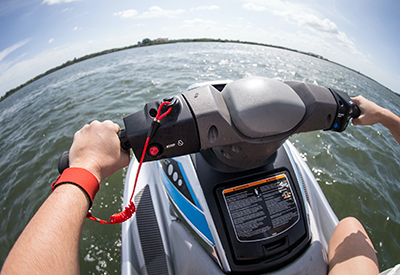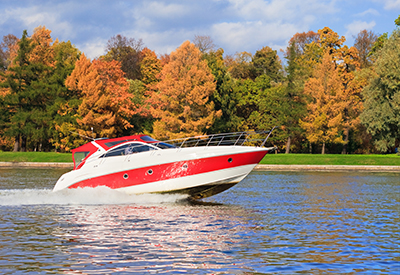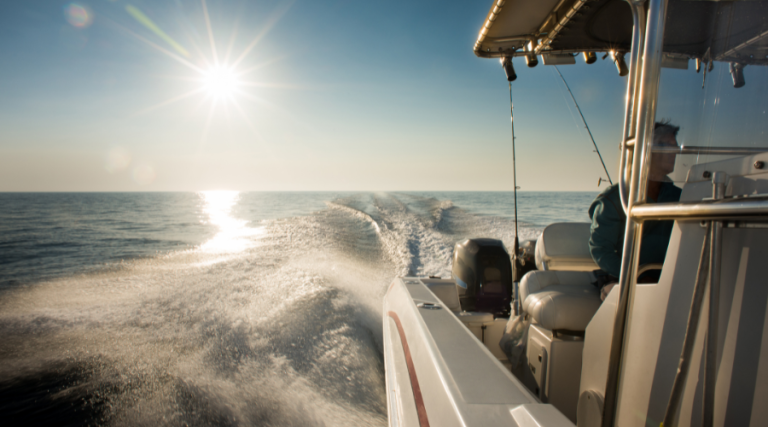7 Smart Safety Suggestions for Spring
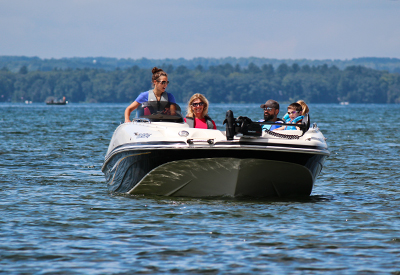
Be prepared, be equipped, stay in touch
By Andy Adams
Photo credit Stearns
I remember with fondness, our opening days at the cottage when my two sons were young. They couldn’t wait to get into their bathing suits and would go charging down the dock to leap into the lake, only to come charging out seconds later howling from the shock of hitting the cold water. As a parent (with a slightly twisted sense of humour), I let them discover how cold the lake was for themselves. Of course, parents were standing by, ready to offer assistance if needed and as they got to be 8 or 10 years old, no further warnings were required.
In the last two or three years, many people have taken up boating as a new interest and activity. Getting out in a boat was a great way to deal with the lockdowns from the global pandemic, and it will always be a great way to make the most of our beautiful Canadian summers.
New boater or old hand, in this article, we will assume that you already have the basics; that you have taken a boating course, that you have your Pleasure Craft Operator Card and that you have equipped your boat with the safety equipment required for that size of vessel.
However, even as a refresher for experienced boaters, a great starting point is a visit to Canada’s Office of Boating Safety, a part of Transport Canada, https://tc.canada.ca/en/marine-transportation/marine-safety/office-boating-safety . Another great resource is the Canadian Safe Boating Council, www.csbc.ca. At the end of this article, (and in places throughout) we’ll have a whole list of useful resources for you and most are free.
These are our 7 Smart Safety Suggestions for Spring 2022. Only a few of these ideas are expensive and all of them are very valuable in the contribution they can make to your enjoyment as a boater.
Is boating a safe activity?
According to the National Marine Manufacturers Association in Canada, well over 12 million adult Canadians go boating every year. On average 120 people annually become boating fatalities and while losing even one life is tragic, statistically boating is a very safe activity.
It’s worth mentioning that of those boating fatalities, 40% are the result of the boat capsizing, being in a collision, or of a person falling overboard accidentally.
Remembering my young sons for a moment, they were jumping into the lake on the 24th of May weekend and it was still shockingly cold water here in Ontario. For those who go fishing or boating earlier or later in the season, be aware that accidentally landing in cold water causes an involuntary gasp reflex. That gasp draws in a mouthful of water and then drowning may be only seconds away.
To learn more about the dangers of cold water visit: https://csbc.ca/en/cold-water-awareness
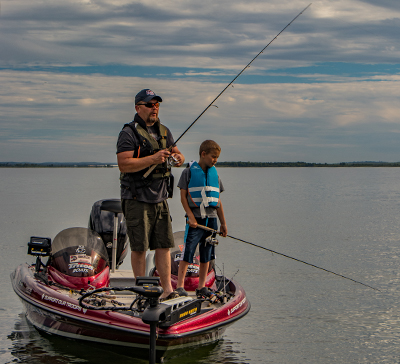 Suggestion #1 – Get a great lifejacket
Suggestion #1 – Get a great lifejacket
For many adults, an inflatable PFD will be the most comfortable while an inherently buoyant vest may be best for young people. Credit: Stearns
The best lifejacket is the one that you are willing to wear, whenever you are on the boat. Years of police statistics have shown that 40% of boating fatalities are the result of capsizing, a collision or falling overboard. In those cases, there’s no time to grab a lifejacket before you hit the water. Another important point is that once a person has fallen into the water, it is almost impossible for them to put a lifejacket on. Just try it sometime…
You have to be wearing it before you hit the water which is why you should be wearing your life jacket at all times in the boat. Properly “fitting” and maintaining your life jacket is a very important part of all-day comfort.
Tips for Proper PFD Fitting
Sizing Information:
PFDs for children have weight limits, whereas adult sizes are based on chest measurement and body weight. For kids, make sure the PFD fits your child’s weight. Also, make sure the PFD is comfortable and light so your child will wear it. And don’t forget to have your child try on the PFD before you buy it. It should fit snugly and not ride up over your child’s chin or ears. If there are more than 7.6 cm (3”) between your child’s shoulders and the device, it is too big and could do more harm than good.
When buying a PFD for children, look for these safety features:
- A large collar for head support
- Waist ties or elastic gathers in front and back
- A safety strap that goes between the legs to prevent the device from slipping over your child’s head
- Buckles on safety straps and reflective tape
- Consider attaching a non-metallic pealess whistle to the device
Fitting for your PFD:
For adults, your chest size—not your weight—will determine what size is right. Sizes vary by PFD brand and model, so check for the size info listed. A PFD should be snug and fit like a glove, yet allow you to move freely and not chafe moving. Women should consider women-specific PFDs versus unisex styles. Women’s PFDs may offer a better fit. Each PFD will have a different design and foam placement to fit the contours of the body. It doesn’t matter where the foam is located safety-wise, but comfort-wise you want it to fit comfortably. The more straps it has, the more adjustments can be made to customize the fit.
Once you’ve selected the right size PFD, follow these fitting steps:
- Loosen all the straps, put the PFD on and zip it up
- Start at the waist and tighten all the straps. If it has shoulder straps, tighten them last. It should feel snug but not uncomfortable
- Next, have someone pull up on the PFD shoulders. If it moves up past your nose or head, try tightening the straps. If it still moves up, the PFD is too large
- The right size may seem “thick,” but check your movements to make sure it is comfortable and will not chafe anywhere while moving or turning
- If possible, test your PFD in a pool or shallow water to see how it works. It should not ride up or slip over your chin while floating
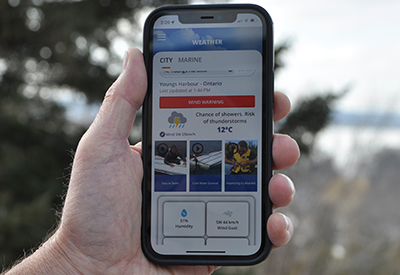 Suggestion #2 – Check the “Weather to Boat” before you go
Suggestion #2 – Check the “Weather to Boat” before you go
The weather can change quite abruptly, and marine weather is NOT the same as general forecasts. The sunny great day onshore can be a day of wind and high waves out on the water. The marine forecast will predict wind speeds and wave heights that a conventional forecast does not. There are specific marine forecasts for your boating area. One great source of information (that is free) is the “Weather To Boat” app that you can download to your cell phone, https://weathertoboat.ca/ .
Weather To Boat will become your “Boating Go To” App. You can easily find all the key information you need for your boating adventure. Create and file your Trip Plan, verify that you have the required safety equipment, check the weather, refresh your memory on the rules of the road and use the pre-departure checklists to ensure you have everything you need.
Weather to Boat also includes a Canada-wide listing of marinas, launch ramps, helpful tips and far more…and it’s free!
Downloading the Weather to Boat app takes seconds and will be there on your phone whenever you need it.
If you have a boat with a stereo system, another great source of Marine Weather is available through SiriusXM, along with all sorts of ad-free music! Many newer boats come with a sound system including a radio with the ability to receive SiriusXM. Have a look at their website: https://www.siriusxm.ca/marine/
SiriusXM Marine is a satellite service, so the signal can come in strong across the continental United States, southern Canada and coastal regions, up to 150 nautical miles offshore. Sirius XM Marine provides graphical weather and fishing info for boaters, allowing you to know the conditions ahead.
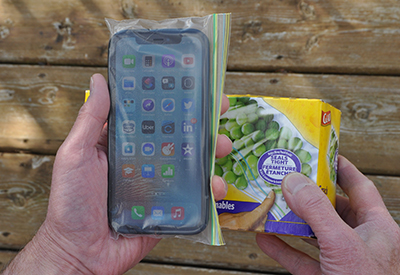 Suggestion #3 – Take your cell phone
Suggestion #3 – Take your cell phone
A simple ziplock bag keeps the water out.
As if you would ever leave your phone behind! But, for near-shore boating, this is a reminder that your cell phone is important. Some phones or phone cases are water-resistant, but I just slip mine into a zip-lock bag. It works perfectly in the bag and stays dry when I’m out in my rowing skiff.
Last summer, a group of people rented kayaks and went out on Lake Simcoe. They were novice paddlers, didn’t think about possible changes in the weather and the group were blown far off-course, out into the middle of the lake. The waves got higher, the dark-coloured kayaks capsized, and the paddlers were in serious trouble.
One had a cell phone that was still working. She called 911 and the police marine unit was sent out. The challenge was that the paddlers could not explain to the 911 operator where they were.
The kayaks were nearly impossible to see in the dark water and high waves. The 911 operator kept the woman talking and on the line as the police boat searched for them. Finally, she saw the police boat and was able to guide them to her position – everyone was saved.
That was a happy ending, but not every cell phone could have done that, and cellular service isn’t always good in cottage country or offshore…so then what do you do to stay safe?
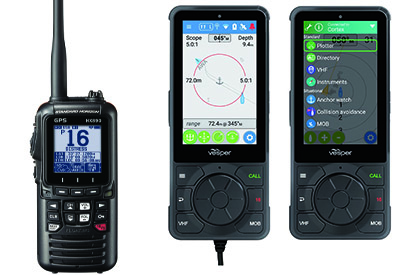 Suggestion #4 – Get a VHF Radio and your VHF License
Suggestion #4 – Get a VHF Radio and your VHF License
For under $300 you could carry this floating, hand-held VHF radio on any boat.
For retail prices less than $300 Canadian, you can get a top-quality hand-held VHF radio with Digital Selective Calling (DSC). This Marine Radio requires that you get your VHF Radio license and that gives you some great education and knowledge. Contact the Canadian Power and Sail Squadrons at www.cps-ecp.ca for available courses near you and remember, you don’t need a big boat or a big budget to have a VHF radio.
Once you have a VHF radio and license, register to get your MMSI (Maritime Mobile Service Identity). This number is unique to you and having it enables you to set up Digital Selective Calling (DSC) on your VHF. New VHF radios have a big, bright red DSC distress button. In an emergency, you just need to push that button and the radio automatically sends your distress signal to the Coast Guard (Canadian or US) and other vessels in the area with your identification and your location.
In addition to the DCS safety benefit, you can contact the Coast Guard, your marina, your fishing buddies or your cruising friends without further cost.
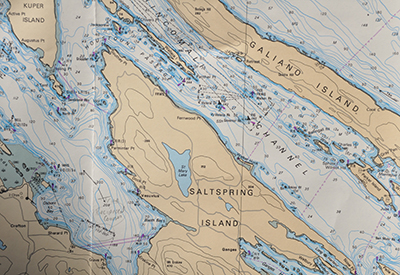 Suggestion #5 – Know where you are
Suggestion #5 – Know where you are
A printed chart is best for planning ahead.
Since ancient times, mariners have relied on maps and charts to plan their voyage. I’ve seen people straining to make out a map on their cellphone, but that’s not a good idea. “Google Maps” is not a navigation chart. Before you set out on any voyage, get the proper Canadian Hydrographic Services charts for the area and look them over carefully. If you know the area and where you plan to go, (or not go) including shoals and other hazards, your day will be much more enjoyable. Electronic cartography on a multi-function display at the helm is very good, but it’s not the same as being able to spread out a chart of the whole voyage to plan ahead.
If you plan to visit new areas, consider buying the PORTS Cruising Guide for that area. These have both aerial and ground-level photography, information about marinas, docking, restaurants, tourist points of interest and more. Best of all, it’s an enjoyable way to plan your trip from the comfort of your easy chair and then take your PORTS Cruising Guide with you onboard. Visit: https://www.portsbooks.com/
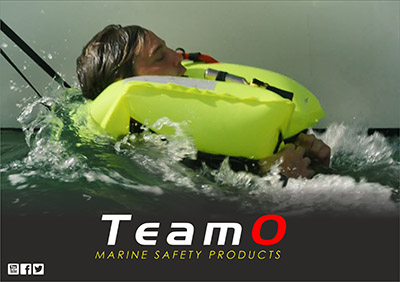 Suggestion #6 – Learn about MOB
Suggestion #6 – Learn about MOB
This is a racing harness by TeamO called a BackTow. It flips the person onto their back keeping their face out of the water in a man overboard situation.
Don’t just think of “man overboard” – think of child, or pet overboard, and the fact that this can happen from the deck of a big cruiser or over the side of a small fishing boat. The procedure is basically the same no matter what and if you have taken the time to read about it, you are far more likely to get it right if it ever happens on your boat.
The Canadian Yachting Onboard newsletter recently included a detailed explanation by John Gullick of the Canadian Power and Sail Squadrons, of what to do in a man overboard situation. You can read it at this link: https://canadianboating.ca/diy/safety/6920-safety-man-overboard-procedures
or visit the Transport Canada website: https://tc.canada.ca/en/marine-transportation/marine-safety/person-overboard
We wanted to note a really neat innovation by TeamO. For safety reasons, sailors often wear a PFD with a harness to be tethered to the boat on a jack line. Unfortunately, too many sailors have drowned at the end of their tethers because they could not hold their faces clear of the water while being dragged by the boat. The TeamO Inflatable PFD solves this problem through its patented BackTow™ technology, which when deployed, transfers the anchor point of the harness from the front of the jacket to the back. As a result, a MOB (man overboard) is pulled through the water back-first and face-up, making breathing possible. To learn more about BackTow Technology you can click on the following link https://www.youtube.com/watch?v=KSC8EasVhfg&feature=emb_logo
 Suggestion #7 – Get an electronic visual distress signal
Suggestion #7 – Get an electronic visual distress signal
Sirius Signal now offers a Transport Canada approved electronic visual distress signal device.
Recently, Transport Canada has approved the use of electronic visual distress signal devices (eVDSD) as a nighttime distress signal for pleasure craft. The C-1002 from Sirius Signal is the industry’s first and only two-color distress light approved for carriage, that legally replaces the need to carry pyrotechnic marine flares in smaller pleasure craft, (although we understand that a day-time smoke flare will still be required). The C-1002 includes features that enhance its functionality to the level of an alert and notification system.
The C-1002 flashes the internationally known SOS distress signal — three short flashes, three long flashes, three short flashes, using a two-color SOS and a separate infrared SOS flash pattern (red/orange and cyan) that has been found more effective against shoreline background light clutter, according to studies conducted by the U.S. Coast Guard R&D Center. The C-1002 is also Bluetooth-enabled with advanced mobile app connectivity, providing an additional layer of protection and communication for recreational boaters — and its infrared signal will be recognized by SAR aircraft from miles overhead.
While vessels under 6 metres in length are not required to carry flares, these new electronic visual distress signal devices can be relatively inexpensive and are a great safety addition to any boat.
CONCLUSION
Be prepared, be equipped, stay in touch – every boater who has taken the time to learn what knowledge is required and what safety equipment has been mandated, will be better equipped to enjoy their time out on the water, and should they encounter a problem, they will be ready to manage it.
Also, staying in touch is very important. File a float plan through your Weather to Boat App, tell the marina and your family where you are planning to go and when you will be back. If you stay in touch, they will quickly realize when you get off-plan or off-schedule and can reach out for assistance.
If something does go wrong, time will be of the essence. But, the better prepared you are, the less likely it is that you will ever need any help.
Wishing you a great summer in 2022!

